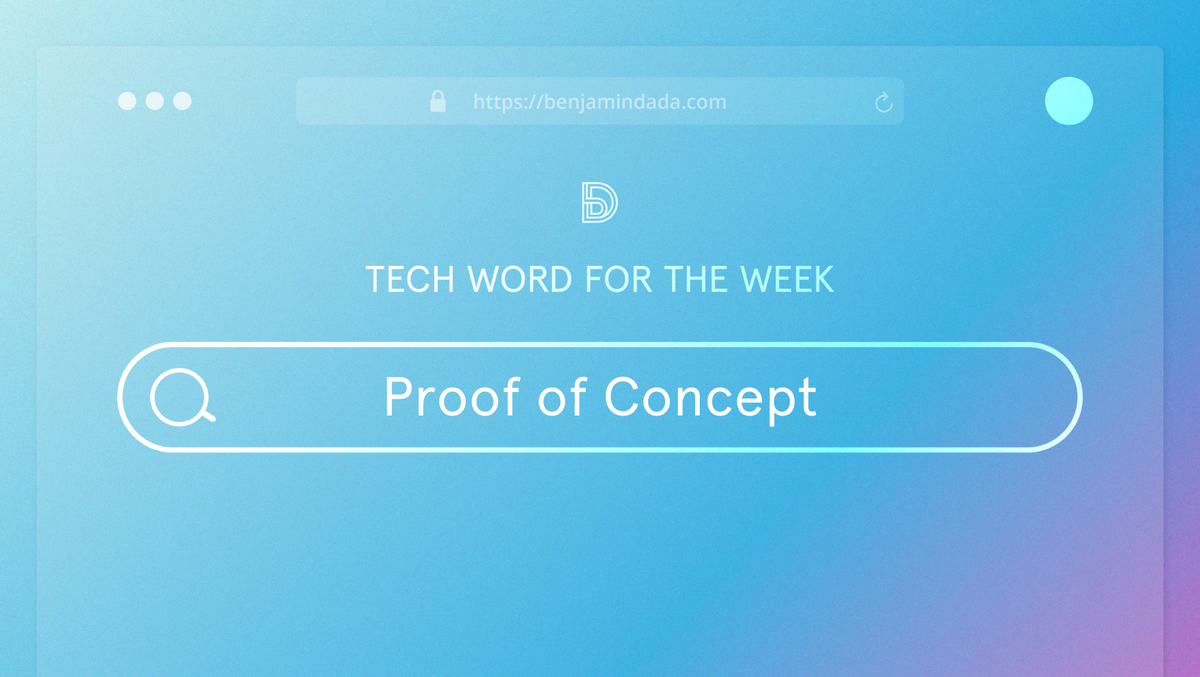Proof of concept
Proof of Concept is a systematic process to examine the viability of a product idea before valuable resources are invested into it.

Tech Word For The Week is a weekly series where we look to explain commonly used words in the tech ecosystem in a simple, engaging way.
The prospect of launching an innovative product with the capacity to solve a problem for millions of people sounds exciting. However, things don't always turn out linear for most ‘would be’ founders.
A report by Harvard business review revealed that two-thirds of startups never show a positive return. A key reason for this is startups invest time and effort to create products that may prove to be useless and simply won’t sell.
There’s a systematic process to examine the viability of a product idea before valuable resources are invested into it. The initial check increases the chances of building a useful solution people will genuinely like to use. The systematic process is through a Proof of Concept (PoC).
Definition of Proof of Concept
PoC is a process of finding out the feasibility and viability of an idea in the real world. It demands a "Yes" or "No" for idea practicality, unique value proposition, adoptability and cost.
Typically done internally, it is a demonstration which tries to verify the viability of the product. PoC investigates if the idea can be done technically. It’s like proving a hypothesis. PoC is an ideas proof evidence that verifies its practical potential. It validates an idea’s feasibility and builds its business confidence.
A PoC helps to define these things:
- If the selected technology meets project needs.
- If the product can perform as envisioned.
- If the overall solution will be feasible.
For instance, you want to build an aeroplane. PoC is testing if the fixed-wing machine can fly. The proof of concept, in this case, can be a simple kite. You launch the kite, it flies, you have verified that it can fly, but uncontrollably and for a short period of time.
The concept has been proven but you have to figure out the means to turn the kite into a controllable flight machine. At this point, gliders can come into the picture. After that you’d have to figure out how to power your glider, make it comfortable and capable of long flights. Following this step by step process gets you an aeroplane all because you have proven that machines can fly.
The whole essence of the proof of concept is to validate the need for an idea, application, or proposed system and prove it can work in real life before you go all in into product development.
Difference between Minimum Viable Product (MVP) vs Proof of Concept (PoC)
The PoC is a concept still at the idea stage and under examination to confirm its market viability. MVP on the other hand is a concrete version of your product idea ready to be taken to the market.
PoC is conducted internally while the MVP needs to be taken to the market. MVP offers a tangible foundation you can present to the users while PoC is an estimated projection of how the proposed product will perform.
Finally, both methods share some similarities but their differences make it possible to use them together when developing a product or service.
Pros of PoC
- Avoid choosing the wrong product
Most startup founders make the mistake of wasting time, resources and money building a product no one wants. Doing a proof of concept guarantees that you are choosing the right product, for the right market, to meet the right need, at the right price.
2. Determine technical practicality
PoC helps to ascertain the need for a product and its technical feasibility. It helps the engineering team to proactively decide on how to scale the product and handle large traffic.
3. Proactive identification of market needs
The process of creating a PoC initially demands you identify specific market needs and pain points. After the need is identified, then the ideal product can be created to solve it. This helps to ensure the product is not detached from reality and brings actual value to end users.
4. Verify Product Limitations
Creating a PoC will help owners understand the limitations, advantages, and disadvantages of their product idea. During the process, they will be able to discover the different options and choose the best direction.
5. Saves Cost
A lot of capital can be saved when the founders have a clearly defined budget and know what to spend money on and what not to. This makes the most of investors’ funds and prevents spending money on a product that the market will eventually find useless.
Cons of PoC
Proof of concept is an idea. And ideas which can be fragile and flimsy. The PoC might differ from the end product at the end of the day. After the concept is verified during the product development some features might have to change. This means the original plan has to be jettisoned and you have to come up with something new.
Key Takeaways
- PoC is an ideas proof evidence that verifies its practical potential.
- PoC guarantees that you are choosing the right product, for the right market, to meet the right need, at the right price.







Comments ()